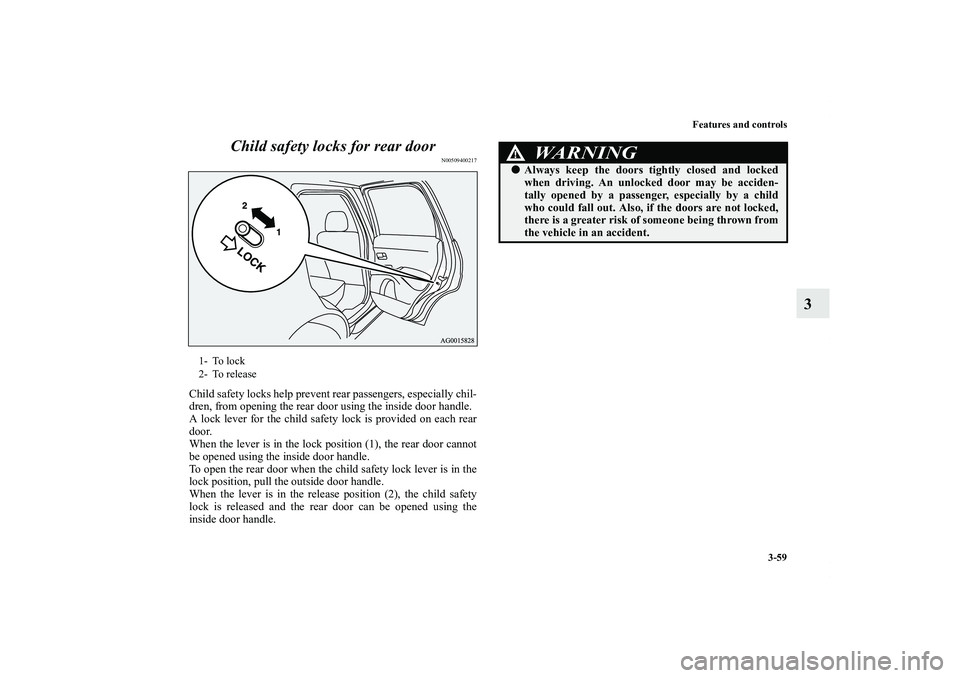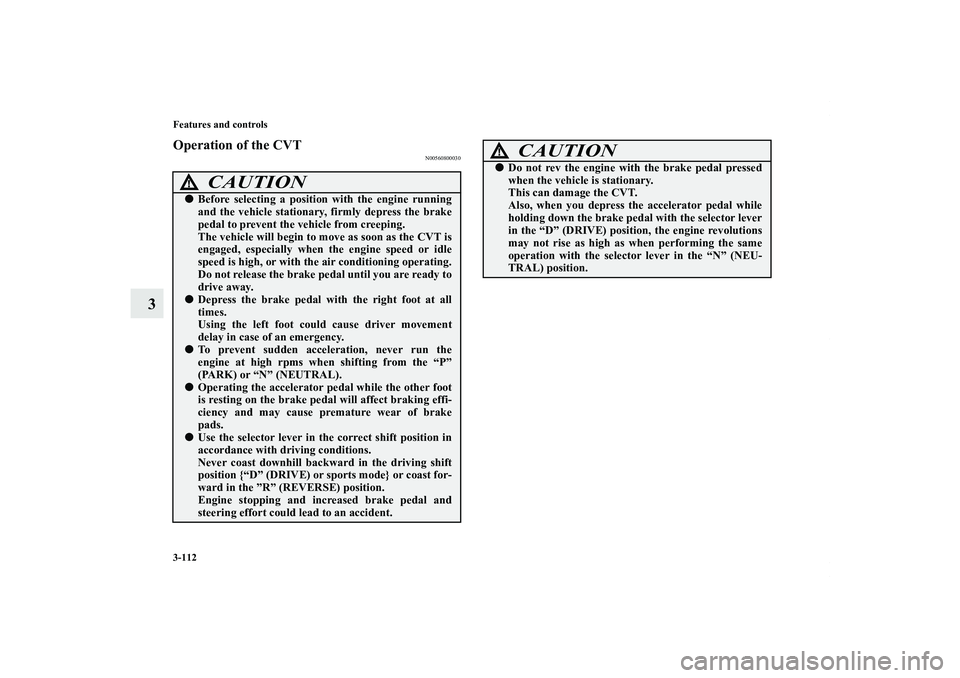Page 137 of 714
3-22 Features and controls
3
To unlockWhile carrying the F.A.S.T.-key within the operating range,
you can unlock the doors and the tailgate by using the F.A.S.T.-
key operation.
The dome light will turn on for 30 seconds. The turn signal
lights will blink twice and the buzzer will sound twice.
Also refer to “Door locks”, “Power door locks” and “Flap-fold
tailgate” on pages 3-53, 3-57 and 3-60 respectively.
Press the driver’s door lock/unlock switch (A) to unlock only
the driver’s door.
Within about 2 seconds, press the driver’s door lock/unlock
switch one more time to unlock all the doors and the tailgate.
NOTE�Settings can be changed so that all doors and the tailgate
are unlocked automatically by pressing the driver’s door
lock/unlock switch once.
Refer to “Setting of door and tailgate unlock function” on
page 3-48.
Driver’s door lock/unlock switchBK0138000US.book 22 ページ 2011年4月13日 水曜日 午前11時17分
Page 168 of 714

Features and controls
3-53
3 Door locks
N00509200505
To lock and unlock with the key (driver’s door)Turn the key toward the front of the vehicle to lock the door.
After checking that the door is locked, turn the key back to the
center and remove it.NOTE�When locking or unlocking with the key, only the driver’s
door will be locked or unlocked.
To lock or unlock all doors and tailgate, use the power
door lock switch, the keyless entry system or the F.A.S.T.-
key operation.
Refer to “Power door locks” on page 3-57, “Keyless entry
system” on pages 3-9 and 3-45, and “To operate using the
F.A.S.T.-key” on page 3-20.
WA R N I N G
!�Make sure all doors are tightly closed and locked
while driving.
• Locked doors, in combination with the use of seat
belts, can help reduce the risk of ejection in an
accident.
• Locked doors can help keep passengers, especially
small children, from opening doors and falling out
of moving vehicles.
• Locked doors can help prevent outsiders from
gaining access to your vehicle when you slow or
come to a stop.
�Lock your vehicle whenever you leave it. Children
who get into unlocked vehicles may not be able to
get out. Children trapped inside vehicles can quickly
be overcome by heat and suffer serious injury or
death due to heat stroke.�Never leave a child alone in the vehicle. In addition
to the risk of heat stroke, children can activate
switches and controls, resulting in an injury or fatal
accident.�When closing a door, make sure that the door is fully
closed and the door-ajar warning display goes out
on the information screen on the multi-information
display. If the door is ajar it could open while driv-
ing and cause an accident.
1- Insert or remove the key
2- Lock
3- Unlock
BK0138000US.book 53 ページ 2011年4月13日 水曜日 午前11時17分
Page 174 of 714

Features and controls
3-59
3 Child safety locks for rear door
N00509400217
Child safety locks help prevent rear passengers, especially chil-
dren, from opening the rear door using the inside door handle.
A lock lever for the child safety lock is provided on each rear
door.
When the lever is in the lock position (1), the rear door cannot
be opened using the inside door handle.
To open the rear door when the child safety lock lever is in the
lock position, pull the outside door handle.
When the lever is in the release position (2), the child safety
lock is released and the rear door can be opened using the
inside door handle.1- To lock
2- To release
WA R N I N G
!�Always keep the doors tightly closed and locked
when driving. An unlocked door may be acciden-
tally opened by a passenger, especially by a child
who could fall out. Also, if the doors are not locked,
there is a greater risk of someone being thrown from
the vehicle in an accident.
BK0138000US.book 59 ページ 2011年4月13日 水曜日 午前11時17分
Page 189 of 714

3-74 Features and controls
3
Lock switch
N00549000143
When this switch is in the lock mode, the passenger door
switches cannot be used to open or close the door windows,
and the main switch will open or close only the driver’s door
window. To unlock the switch, press it again.
Safety mechanism (Driver’s door window only)
N00528800119
If a hand or head is trapped, for safety the door window is auto-
matically lowered a little.
After the door window is lowered, pull up the switch again to
close the door window.
1- Lock
2- Unlock
WA R N I N G
!�Before driving with a child in the vehicle, be sure to
lock the window switch to make it inoperative. Chil-
dren tampering with the switch could easily trap
their hands or heads in the window.
WA R N I N G
!�If the safety mechanism is activated three or more
times successively, the safety mechanism will be tem-
porarily cancelled.
If a hand or head got trapped, a serious injury could
result.
CAUTION
!�The safety mechanism is deactivated just before the
door window closes. This allows the door window to
close completely. Therefore be especially careful that
fingers are not trapped in the door window opening.�The safety mechanism is deactivated while the
switch is pulled up. Therefore be especially careful
that fingers are not trapped in the door window
opening.�Do not deliberately trap your hands or head in
order to activate the safety mechanism.
Your hand or head could be trapped and personal
injury could result.
BK0138000US.book 74 ページ 2011年4月13日 水曜日 午前11時17分
Page 193 of 714
3-78 Features and controls
3
SunshadeThe sunshade can be opened or closed manually while the sun-
roof is closed.
CAUTION
!�The safety mechanism is deactivated while the
switch (2) is pressed. Therefore be especially careful
that fingers are not trapped in the sunroof opening.�Do not deliberately trap your hands or head in
order to activate the safety mechanism.
Personal injury and malfunction of the sunroof
could result.
CAUTION
!�Do not attempt to close the sunshade when the sun-
roof is opened.�Be careful that hands are not trapped when closing
the sunshade.
BK0138000US.book 78 ページ 2011年4月13日 水曜日 午前11時17分
Page 217 of 714

3-102 Features and controls
3
Operation of the automatic transaxle
N00514500320
CAUTION
!�Before selecting a gear with the engine running and
the vehicle stationary, firmly depress the brake
pedal to prevent the vehicle from creeping.
The vehicle will begin to move as soon as the gear is
engaged, especially when the engine speed or idle
speed is high, or with the air conditioning operating.
Do not release the brake pedal until you are ready to
drive away.�Depress the brake pedal with the right foot at all
times.
Using the left foot could cause driver movement
delay in case of an emergency.�To prevent sudden acceleration, never run the
engine at high rpms when shifting from the “P”
(PARK) or “N” (NEUTRAL).�Operating the accelerator pedal while the other foot
is resting on the brake pedal will affect braking effi-
ciency and may cause premature wear of brake
pads.�Use the selector lever in the correct shift position in
accordance with driving conditions.
Never coast downhill backward in the driving shift
position {“D” (DRIVE) or sports mode} or coast for-
ward in the “R” (REVERSE) position.
Engine stopping and increased brake pedal and
steering effort could lead to an accident.
�Do not rev the engine with the brake pedal pressed
when the vehicle is stationary.
This can damage the transaxle.
Also, when you depress the accelerator pedal while
holding down the brake pedal with the selector lever
in the “D” (DRIVE) position, the engine revolutions
may not rise as high as when performing the same
operation with the selector lever in the “N” (NEU-
TRAL) position.
CAUTION
!
BK0138000US.book 102 ページ 2011年4月13日 水曜日 午前11時17分
Page 227 of 714

3-112 Features and controls
3
Operation of the CVT
N00560800030
CAUTION
!�Before selecting a position with the engine running
and the vehicle stationary, firmly depress the brake
pedal to prevent the vehicle from creeping.
The vehicle will begin to move as soon as the CVT is
engaged, especially when the engine speed or idle
speed is high, or with the air conditioning operating.
Do not release the brake pedal until you are ready to
drive away.�Depress the brake pedal with the right foot at all
times.
Using the left foot could cause driver movement
delay in case of an emergency.�To prevent sudden acceleration, never run the
engine at high rpms when shifting from the “P”
(PARK) or “N” (NEUTRAL).�Operating the accelerator pedal while the other foot
is resting on the brake pedal will affect braking effi-
ciency and may cause premature wear of brake
pads.�Use the selector lever in the correct shift position in
accordance with driving conditions.
Never coast downhill backward in the driving shift
position {“D” (DRIVE) or sports mode} or coast for-
ward in the ”R” (REVERSE) position.
Engine stopping and increased brake pedal and
steering effort could lead to an accident.
�Do not rev the engine with the brake pedal pressed
when the vehicle is stationary.
This can damage the CVT.
Also, when you depress the accelerator pedal while
holding down the brake pedal with the selector lever
in the “D” (DRIVE) position, the engine revolutions
may not rise as high as when performing the same
operation with the selector lever in the “N” (NEU-
TRAL) position.
CAUTION
!
BK0138000US.book 112 ページ 2011年4月13日 水曜日 午前11時17分
Page 232 of 714

Features and controls
3-117
3 S-AWC (Super-All Wheel Control)
(if so
equipped)N00541300049
S-AWC is an integrated vehicle dynamics control system that
enhances driving performance, cornering performance and
vehicle stability over a wide range of driving conditions. It
does this by integrated controls over the front-rear distribution
of driving torque to the wheels and the left-right distribution of
driving torque to the front wheels.NOTE�If the parking brake lever is pulled up while the vehicle is
moving, the front-rear distribution of driving torque con-
trol will be forced to turn OFF which will allow the rear
wheel to lock easier.
CAUTION
!�Always use tires of the same size, type, and brand
that have no wear differences. Using tires that differ
in size, type, brand, or wear amount may activate
the protection of the drive-system components, caus-
ing the drive mode in “4WD AUTO” mode to lock or
the “4WD” and “LOCK” indicators to blink alter-
nately.
CAUTION
!�Do not over-rely on the S-AWC. Even the S-AWC
cannot prevent the natural laws of physics from act-
ing on the vehicle. This system, like any other sys-
tem, has limits and cannot help you to maintain
traction and control of the vehicle in all circum-
stances. Reckless driving can lead to accidents. It is
the driver’s responsibility to drive carefully. This
means taking into account the traffic, road and envi-
ronmental conditions.�Be sure to use tires that are the same specified size,
type, and brand, and have no difference in the
amount of wear for all four wheels. Otherwise, the
S-AWC may not work properly.
BK0138000US.book 117 ページ 2011年4月13日 水曜日 午前11時17分